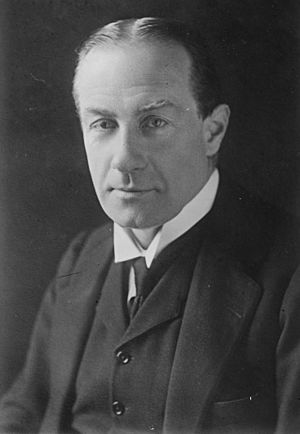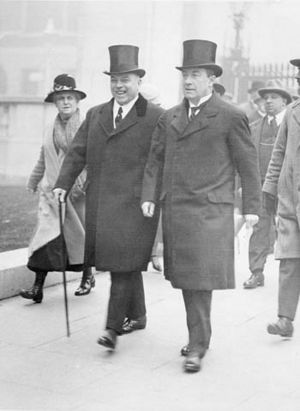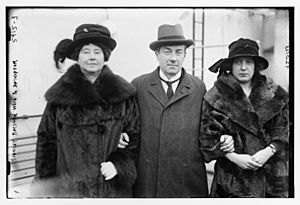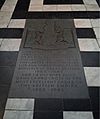Stanley Baldwin facts for kids
Quick facts for kids
The Earl Baldwin of Bewdley
|
|||||||||||||||||||||||||||||||||||
|---|---|---|---|---|---|---|---|---|---|---|---|---|---|---|---|---|---|---|---|---|---|---|---|---|---|---|---|---|---|---|---|---|---|---|---|

Baldwin in 1920
|
|||||||||||||||||||||||||||||||||||
| Prime Minister of the United Kingdom | |||||||||||||||||||||||||||||||||||
| In office 7 June 1935 – 28 May 1937 |
|||||||||||||||||||||||||||||||||||
| Monarch | |||||||||||||||||||||||||||||||||||
| Preceded by | Ramsay MacDonald | ||||||||||||||||||||||||||||||||||
| Succeeded by | Neville Chamberlain | ||||||||||||||||||||||||||||||||||
| In office 4 November 1924 – 4 June 1929 |
|||||||||||||||||||||||||||||||||||
| Monarch | George V | ||||||||||||||||||||||||||||||||||
| Preceded by | Ramsay MacDonald | ||||||||||||||||||||||||||||||||||
| Succeeded by | Ramsay MacDonald | ||||||||||||||||||||||||||||||||||
| In office 22 May 1923 – 22 January 1924 |
|||||||||||||||||||||||||||||||||||
| Monarch | George V | ||||||||||||||||||||||||||||||||||
| Preceded by | Bonar Law | ||||||||||||||||||||||||||||||||||
| Succeeded by | Ramsay MacDonald | ||||||||||||||||||||||||||||||||||
| Lord President of the Council | |||||||||||||||||||||||||||||||||||
| In office 24 August 1931 – 7 June 1935 |
|||||||||||||||||||||||||||||||||||
| Prime Minister | Ramsay MacDonald | ||||||||||||||||||||||||||||||||||
| Preceded by | The Lord Parmoor | ||||||||||||||||||||||||||||||||||
| Succeeded by | Ramsay MacDonald | ||||||||||||||||||||||||||||||||||
|
|||||||||||||||||||||||||||||||||||
|
|||||||||||||||||||||||||||||||||||
|
|||||||||||||||||||||||||||||||||||
| Personal details | |||||||||||||||||||||||||||||||||||
| Born | 3 August 1867 Bewdley, England |
||||||||||||||||||||||||||||||||||
| Died | 14 December 1947 (aged 80) Stourport-on-Severn, England |
||||||||||||||||||||||||||||||||||
| Resting place | Worcester Cathedral | ||||||||||||||||||||||||||||||||||
| Political party | Conservative | ||||||||||||||||||||||||||||||||||
| Spouse |
Lucy Ridsdale
(m. 1892; died 1945) |
||||||||||||||||||||||||||||||||||
| Children | 7, including Oliver and Arthur | ||||||||||||||||||||||||||||||||||
| Parents |
|
||||||||||||||||||||||||||||||||||
| Education | Harrow School | ||||||||||||||||||||||||||||||||||
| Alma mater | Trinity College, Cambridge | ||||||||||||||||||||||||||||||||||
| Occupation |
|
||||||||||||||||||||||||||||||||||
| Signature | |||||||||||||||||||||||||||||||||||
Stanley Baldwin, 1st Earl Baldwin of Bewdley (born August 3, 1867 – died December 14, 1947) was an important British politician. He was a member of the Conservative Party. Baldwin served as Prime Minister three times between the two World Wars. He led the country from May 1923 to January 1924, from November 1924 to June 1929, and again from June 1935 to May 1937.
Contents
- Early Life and Family
- Starting in Politics
- First Time as Prime Minister (1923–1924)
- Leading the Opposition (1924)
- Second Time as Prime Minister (1924–1929)
- Leading the Opposition Again (1929–1931)
- Lord President of the Council (1931–1935)
- Third Time as Prime Minister (1935–1937)
- Retirement and Later Life
- Images for kids
- See also
Early Life and Family
Stanley Baldwin was born in Bewdley, England. His family was wealthy and owned a business that made iron and steel. His mother, Louisa MacDonald, was the aunt of the famous writer Rudyard Kipling. Stanley and Rudyard were close friends throughout their lives.
Baldwin went to Harrow School and then studied history at Trinity College, Cambridge. After college, he joined his family's iron manufacturing business. He was known as a good businessman who liked new ideas. When his father died in 1908, Baldwin inherited a lot of money and became a director of the Great Western Railway.
In 1892, Baldwin married Lucy Ridsdale. They had six children who survived to adulthood.
Starting in Politics
Baldwin became a politician later in life. In 1908, he was elected as a Member of Parliament (MP) for Bewdley. He took over this role from his father.
During World War I, he worked as a junior minister. He was the Financial Secretary to the Treasury from 1917 to 1921. This job involved managing the government's money. He even gave a large part of his own money to help pay off Britain's war debt.
In 1921, he was promoted to a more senior role. He became the President of the Board of Trade. This position meant he was in charge of trade and business matters for the country.
Becoming Chancellor
In 1922, many members of the Conservative Party were unhappy. They did not like working with David Lloyd George's government. At a special meeting, Baldwin spoke out. He said he would no longer support Lloyd George.
Because of this, the Conservative Party left the government. A new Conservative leader, Bonar Law, became Prime Minister. He made Baldwin the Chancellor of the Exchequer. This is the minister in charge of the country's finances.
First Time as Prime Minister (1923–1924)
In May 1923, Bonar Law had to resign because he was very ill. Stanley Baldwin was chosen to become the new Prime Minister. He also became the leader of the Conservative Party.
At this time, Britain faced high unemployment. Baldwin wanted to introduce "tariffs." These are taxes on goods imported from other countries. He hoped this would help British businesses and create jobs.
He called an election in December 1923 to get public support for his plan. However, the election results were not clear. The Conservatives won the most seats but did not have a majority. Baldwin's government was defeated in Parliament in January 1924, and he resigned.
Leading the Opposition (1924)
After his resignation, Baldwin remained the leader of the Conservative Party. For the next ten months, the Labour Party formed a government. It was a minority government, meaning they did not have a majority of seats.
In October 1924, another general election was held. Baldwin and the Conservatives won by a large amount. This was partly because the Liberal Party was not very popular. Baldwin became Prime Minister for the second time.
Second Time as Prime Minister (1924–1929)

Baldwin's second government included important figures. These included Winston Churchill as Chancellor of the Exchequer. His government focused on making life better for ordinary people. They introduced reforms in areas like unemployment insurance and old-age pensions. They also worked on clearing slums and improving housing.
The General Strike
A major event during this time was the General Strike in 1926. This was a huge strike by many workers across Britain. Baldwin handled the strike by using emergency powers. He used the military and volunteers to keep important services running. The strike lasted only nine days and ended on May 12. Many people praised Baldwin's government for how they managed the situation.
Improving Electricity
Baldwin also helped improve the country's electricity supply. His government created the Central Electricity Board. This board helped to connect power stations across the country. By 1939, electricity output had grown a lot. More people had electricity in their homes than ever before.
Welfare Reforms
One of Baldwin's important laws was the Widows, Orphans and Old Age Contributory Pensions Act of 1925. This law gave money each week to widows, orphans, and insured workers over 65. This was a big step towards creating a welfare state. It meant the government would help people who could not work.
Leading the Opposition Again (1929–1931)
In the 1929 election, the Labour Party won the most seats. Baldwin's Conservative Party went back into opposition. During this time, some newspaper owners tried to get Baldwin removed as party leader.
However, Baldwin made big improvements to the Conservative Party. He made the party more organized and better at raising money. He also used new ways to reach the public, like radio and film.
Lord President of the Council (1931–1935)
By 1931, the world was facing the Great Depression. This was a time of severe economic hardship. Baldwin and the Conservatives joined with Labour Prime Minister Ramsay MacDonald to form a "National Government."
MacDonald's health was getting worse. So, Baldwin, as Lord President of the Council, took on many of the Prime Minister's duties. He was the de facto (in practice) prime minister.
Changes for the Empire
During this period, an important law was passed: the Statute of Westminster 1931. This law gave full self-government to countries like Canada, Australia, New Zealand, and South Africa. It was a step towards creating the Commonwealth of Nations. This group of countries would work together, moving away from being just the "British Empire."
Views on Disarmament
Baldwin believed that large armies could lead to war. However, he also realized that Britain needed to protect itself. He became worried about Germany building up its military. He said that Britain could no longer reduce its own weapons alone.
He changed his mind from hoping for disarmament to supporting rearmament. This meant building up Britain's own military. He believed that having strong defenses would help prevent war.
Third Time as Prime Minister (1935–1937)
In June 1935, Baldwin officially became Prime Minister again. MacDonald took Baldwin's old role. In October, Baldwin called another general election. He won with a large majority.
Rearming Britain

Baldwin's government began to increase Britain's military strength. This was called "rearmament." They planned to expand the Royal Air Force and improve the Royal Navy and British Army. They also built "shadow factories" to make military equipment.
The Labour Party was against this rearmament program. They wanted total disarmament. But Baldwin believed it was necessary because of the growing threat from countries like Germany.
King Edward VIII's Abdication
Baldwin's last big challenge as Prime Minister was the abdication of King Edward VIII. The new King wanted to marry an American woman named Wallis Simpson. She had been divorced twice.
Baldwin and the government believed that the British people and the Empire would not accept a divorced woman as Queen. The King was also the head of the Church of England, which did not allow marriage after divorce.
Baldwin tried to convince the King not to marry Mrs. Simpson. He explained that the King's decision would harm the monarchy's reputation. The crisis became very serious. Most people in Parliament and the Commonwealth countries supported Baldwin.
The King decided to give up his throne rather than give up Mrs. Simpson. He abdicated on December 11, 1936. His brother became King George VI. Baldwin was praised for handling this difficult situation calmly and wisely.
Retirement and Later Life
Baldwin resigned as Prime Minister on May 28, 1937, shortly after the coronation of King George VI. He was given the title of Earl Baldwin of Bewdley.
After he retired, Baldwin supported the Munich Agreement. This agreement aimed to prevent war with Adolf Hitler's Germany. Baldwin believed that a prime minister should not lead the country into war unless it was fully ready.
During World War II, some people criticized Baldwin. They blamed him for Britain not being fully prepared for the war. A book called Guilty Men was published in 1940. It accused Baldwin and others of not rearming enough.
However, many historians now have a more positive view of Baldwin. They argue that he did what he could given the public's desire for peace at the time. They also say he helped unite the country and prepared it for the challenges ahead.
Baldwin's wife, Lucy, died in 1945. He passed away in his sleep on December 14, 1947, at the age of 80. His ashes were buried in Worcester Cathedral.
Images for kids
-
Astley Hall near Stourport On Severn, Baldwin's home between 1902 and 1947
-
Worcester Cathedral, grave of the 1st Earl Baldwin of Bewdley and his wife Lucy, née Ridsdale
See also
 In Spanish: Stanley Baldwin para niños
In Spanish: Stanley Baldwin para niños
- Interwar Britain
- List of people on the cover of Time Magazine: 1920s






